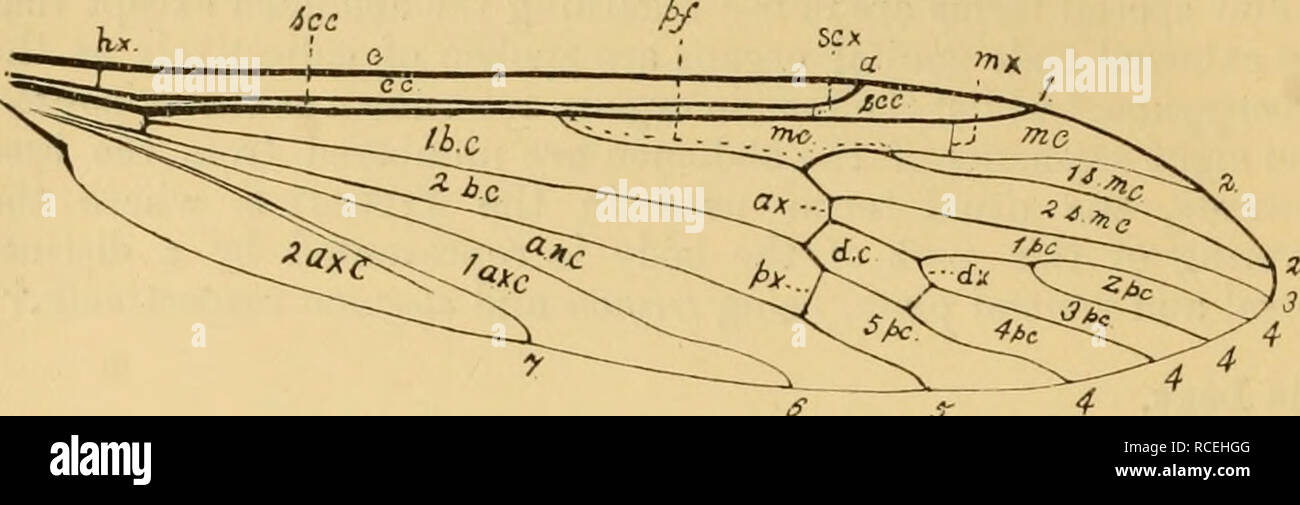. Diptera Nematocera (excluding Chironomidæ and Culicidæ). Diptera. 8 INTRODUCTION. extent. Often it is absent, and occasionally it is present when the pulvilli themselves are wanting. The anterior legs are the four front legs taken together, the posterior legs the four hind legs similarly considered. When spoken of singly they are called the fore (front or first) pair; middle (median or second) pair; and the hind (or third) pair.. Fig. 3.—Wing of Limnophila. c, costal vein. cc, costal cell. a, auxiliary vein. sec, subcostal cell. 1, 1st longitudinal vein. mc, marginal cell (inner and outer).

Image details
Contributor:
Paul Fearn / Alamy Stock PhotoImage ID:
RCEHGGFile size:
7.1 MB (204.7 KB Compressed download)Releases:
Model - no | Property - noDo I need a release?Dimensions:
2795 x 894 px | 23.7 x 7.6 cm | 9.3 x 3 inches | 300dpiMore information:
This image is a public domain image, which means either that copyright has expired in the image or the copyright holder has waived their copyright. Alamy charges you a fee for access to the high resolution copy of the image.
This image could have imperfections as it’s either historical or reportage.
. Diptera Nematocera (excluding Chironomidæ and Culicidæ). Diptera. 8 INTRODUCTION. extent. Often it is absent, and occasionally it is present when the pulvilli themselves are wanting. The anterior legs are the four front legs taken together, the posterior legs the four hind legs similarly considered. When spoken of singly they are called the fore (front or first) pair; middle (median or second) pair; and the hind (or third) pair.. Fig. 3.—Wing of Limnophila. c, costal vein. cc, costal cell. a, auxiliary vein. sec, subcostal cell. 1, 1st longitudinal vein. mc, marginal cell (inner and outer). 2, 2nd do. 1 sm.c, 1st submarginal cell. 3, -3rd do. 2sm.c, 2nd submarginal cell. 4, 4th do. 1 pc, Ist posterior cell. 5, 5th do. 2 pc, 2nd do. 6, 6th do. 3 pc, 3rd do. 7, 7th do. 4 pc, 4th do. ha:, humeral cross-vein. 5 pc, 5th do. sex, subcostal cross-vein. an.c, anal cell. mx, marginal cross-vein. 1 ax.c, 1st axillary cell. ax, anterior cross-vein. 2 ax.c, 2nd do. 2JX, posterior cross-vein. dc, discal cell. pf, prsefurca. I be, 1st basal cell. 2 be, 2rid do. The Wings. The Veins.—As a typical wing from which to illustrate the venation, * having special reference to the Nematoceba, that of Limnophila has been chosen.t The front margin of the wing is known as tlie casta, and is * The term neuration was employed by many of the older authors instead of venation, but the latter is at present in almost universal use. t It must be understood that a diagrammatic wing to expound the whole theory of venation throughout the Diptera is an impossibility, and the wing of Limnophila is selected because it possesses the greatest number of cells and veins in tiie Nematoceka. The relative lengths and positions of these are given in the main as for Livinophila, but it must be understood that these propor- tions vary in different groups and to a still greater extent in different families. The student should be able, after mastering the terminology of one family, to identify the corresponding v